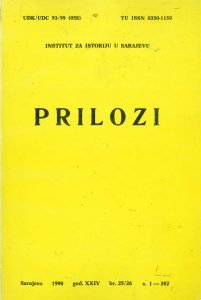SREDNJOVJEKOVNA ŽUPA TREBINJE
THE MEDIEVAL DISTRICT TREBINJE
(A HISTORIC-GEOGRAPHICAL-TOPOGRAPHICAL REVIEW)
Author(s): Đuro TošićSubject(s): Museology & Heritage Studies, History of Church(es), Local History / Microhistory, Middle Ages
Published by: Institut za istoriju
Keywords: Trebinje region; Medieval district; territory;
Summary/Abstract: On the broad parts of Travunia, or the Trebinje region, the Trebinje District was duly formed in time between the districts Popovo on the Western, Žmovice and Konavli on the Southern, Vrm (Korjenici) on the Eastern and Rudine and Ljubomir on the Northern side of the area. In the ancient past there had been different districts on its territory - Šuma (with the settlements; Bjelač, Taleža, Svinjar evo, Klikovići, Gola Glavica, Sparožići, Orah, Zasjek, Začula, Planik, Obrće, Vlaštica, Uskoplje and Ledenice); Površ (with the settlements: Ljubovo, Biograd, Orašje, Mrnjići, Ljekovo, Slivnica, Zagradinje, Bijela, Grebeni, Sopoštica, Drijen, Bobovište, Bobova Ljut, Glavska, Poljice and Kremeni Do); Vrsinje (Zupci) - (with the settlements: Dubrava, Sutjeska, Konjsko, Orašje, Turmenti and Rapti); Trebinjsko polje (with the settlements: Police, Trebinje, ćičevo, Mokro, Zgonjevo, Priđvorci and Gomiljani); Pobrđe (with the settlements: Necvijeće, Mičevac, Jasen, Goica, Pođgljiva, Zasad, Zagora); and Lug (with the settlements: Hum and Cicina); which could be seen today as smaller but clearly recognizable places. A large number of funeral mounds, the stećak necropolis, chapels and church sites, old houses and mansions, as well as the abandoned settlements testify about a population density of this region in the Middle Ages.
Journal: Prilozi
- Issue Year: 1990
- Issue No: 25/26
- Page Range: 65-101
- Page Count: 37
- Language: Bosnian

